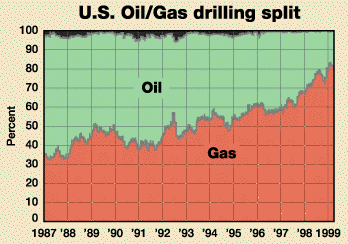What's happening in production
It’s a rush to gas with cool sounds and valves that won’t leakNo doubt, you’ve probably heard that the future of natural gas is bright. Lately, it seems to be getting even better. Many factors — including political, cultural, financial and exciting new technologies — are all converging to further the use of natural gas. In the U.S., the switch to gas is a long-term trend. Look at the chart below. Since 1987, when Baker Hughes began keeping such records, drilling for gas has steadily increased, currently hovering around 83%. One of the factors responsible is the "green" aspect of natural gas. It helps reduce CO2 emissions, which, regardless of whether needed, is desirable to many folks, especially the environmentally minded. Carbon taxes and emissions trading currently imposed or planned will accelerate the trend to gas, since oil and coal release 48% and 86% more CO2 than gas, respectively. Thus, gas is becoming the fuel of choice for communities and governments, especially for generating electricity.
Environmental considerations aside, using gas often just makes good business sense. Calgary-based Mercury Electric Corp. has developed a refrigerator-sized electric turbine that uses flare gas. As associated-gas production varies, the number of turbines can be optimized to provide electricity to the power grid or to remote / local communities throughout the life of the field. The world’s largest land-based methane resources lie in coalbeds. Generally not included in the drilling numbers, U.S. coalbed methane production continues its healthy growth rate of about 10% per year. In Canada’s vast, deep, unminable coalbeds, the Alberta Research Council is leading a group of provincial, national and international organizations in a novel project to test an enhanced-gas-production idea. In a manner similar to enhanced oil recovery, CO2 would be injected into coalbeds and become chemically bound therein, releasing trapped methane. A side benefit would be that it permanently stores unwanted CO2 underground. As you’ve read in this column before, methane hydrates constitute the largest hydrocarbon resource in the world. Efforts are intensifying to develop ways to produce this abundant resource. Later this month, the Japanese National Oil Co. will spud Nankai Trough-1, a methane hydrate well offshore Japan, to further test methane hydrate’s exploitation potential. Aside from hydrates, coalbed gas and associated gas, huge conventional reservoirs of gas lie in remote areas. If not within economic reach of pipelines and markets, they are "stranded" and as such, worthless. The only methods to exploit stranded gas have been cryogenic LNG processes. These require massive economics of scale: a billion-dollar or more investment for the compressor trains and processing plant, at least four or five Tcf of gas reserves and 20-year sales contracts. But the economics of stranded gas may be about to change. Cool sounds. In 1816, Reverend Robert Stirling, of Scotland, invented an external combustion engine. These engines have been tried in automobiles, submarines and refrigeration. A good information source for Stirling engines and their industry use is: www.stirlingcycle.com. This May, in a paper in Nature, Los Alamos National Laboratory researchers Scott Backhaus and Greg Swift describe a Stirling engine that has no moving parts. It uses sound, or thermoacoustic energy, to do the work. The device, which looks like a paint bucket attached to the handle of a basesball bat, is underwhelmingly low-tech. It’s constructed of inexpensive, welded steel pipes and conventional heat exchangers and is, thus, highly reliable. Using any heat source, such as natural gas, the engine could be used for residential cogeneration (heat+electricity), automotive air conditioning (using exhaust heat) or for industrial refrigeration / gas liquefaction (text and photos at: www.lanl.gov/ projects/thermoacoustics/Book/). The U.S. DOE just announced it will co-fund construction and testing of a small-scale, thermoacoustic, Stirling, LNG-production device. It has provided $350,000 to Cryenco, Inc., a Denver-based company that specializes in cryogenic vessels. Cryenco will contribute $200,000 to the project. The company has already built a model that provided 2 kW of refrigeration at 120°K, sufficient for LNG production. The device will be maintenance-free, gas powered and if all goes as planned, profitable at gas-production rates as low as 1 MMcf a day. Whether coalbed, stranded or associated gas, this could place enormous resources within economic reach. Can’t-leak valve? Sure. And it never wears out, right? But that’s exactly what INEEL (Idaho National Engineering and Environmental Laboratory) and inventor John Wordin claim. The valve design is based on a mathematical theory from 1692. Also known as Schiele’s Pivot, the valve is called a Tractrix, which is a weird curve that uniformly wears. Only recently has the technology existed to replicate the curve in metal. When applied to both valve body and mating surface, the tractrix curve is the only shape that forms an ever-tighter seal as the valve wears. After two-and-a-half years of development, the valve is being marketed by Piquniq
Management Corp., a Native-American firm out of Anchorage, Alaska. ARCO Indonesia and BP
Alaska are planning to test the valve for pipeline and "dirty" work.
Copyright © 1999 World
Oil |
- Applying ultra-deep LWD resistivity technology successfully in a SAGD operation (May 2019)
- Adoption of wireless intelligent completions advances (May 2019)
- Majors double down as takeaway crunch eases (April 2019)
- What’s new in well logging and formation evaluation (April 2019)
- Qualification of a 20,000-psi subsea BOP: A collaborative approach (February 2019)
- ConocoPhillips’ Greg Leveille sees rapid trajectory of technical advancement continuing (February 2019)




